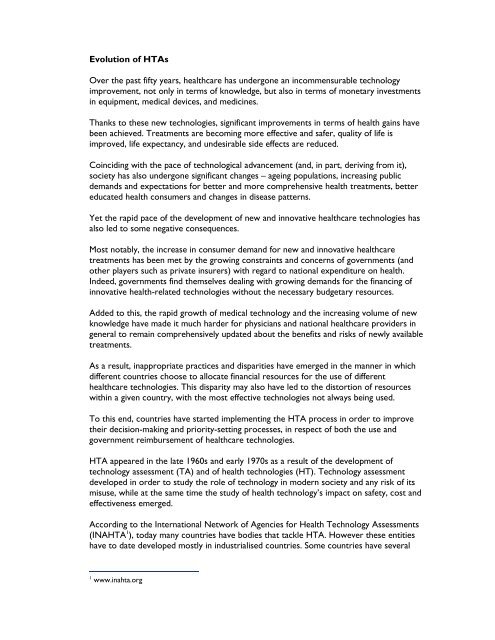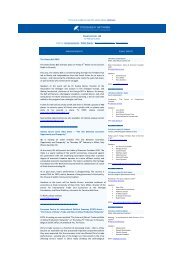An Introduction to Health Technology Assessment - The Stockholm ...
An Introduction to Health Technology Assessment - The Stockholm ...
An Introduction to Health Technology Assessment - The Stockholm ...
Create successful ePaper yourself
Turn your PDF publications into a flip-book with our unique Google optimized e-Paper software.
Evolution of HTAs<br />
Over the past fifty years, healthcare has undergone an incommensurable technology<br />
improvement, not only in terms of knowledge, but also in terms of monetary investments<br />
in equipment, medical devices, and medicines.<br />
Thanks <strong>to</strong> these new technologies, significant improvements in terms of health gains have<br />
been achieved. Treatments are becoming more effective and safer, quality of life is<br />
improved, life expectancy, and undesirable side effects are reduced.<br />
Coinciding with the pace of technological advancement (and, in part, deriving from it),<br />
society has also undergone significant changes – ageing populations, increasing public<br />
demands and expectations for better and more comprehensive health treatments, better<br />
educated health consumers and changes in disease patterns.<br />
Yet the rapid pace of the development of new and innovative healthcare technologies has<br />
also led <strong>to</strong> some negative consequences.<br />
Most notably, the increase in consumer demand for new and innovative healthcare<br />
treatments has been met by the growing constraints and concerns of governments (and<br />
other players such as private insurers) with regard <strong>to</strong> national expenditure on health.<br />
Indeed, governments find themselves dealing with growing demands for the financing of<br />
innovative health-related technologies without the necessary budgetary resources.<br />
Added <strong>to</strong> this, the rapid growth of medical technology and the increasing volume of new<br />
knowledge have made it much harder for physicians and national healthcare providers in<br />
general <strong>to</strong> remain comprehensively updated about the benefits and risks of newly available<br />
treatments.<br />
As a result, inappropriate practices and disparities have emerged in the manner in which<br />
different countries choose <strong>to</strong> allocate financial resources for the use of different<br />
healthcare technologies. This disparity may also have led <strong>to</strong> the dis<strong>to</strong>rtion of resources<br />
within a given country, with the most effective technologies not always being used.<br />
To this end, countries have started implementing the HTA process in order <strong>to</strong> improve<br />
their decision-making and priority-setting processes, in respect of both the use and<br />
government reimbursement of healthcare technologies.<br />
HTA appeared in the late 1960s and early 1970s as a result of the development of<br />
technology assessment (TA) and of health technologies (HT). <strong>Technology</strong> assessment<br />
developed in order <strong>to</strong> study the role of technology in modern society and any risk of its<br />
misuse, while at the same time the study of health technology’s impact on safety, cost and<br />
effectiveness emerged.<br />
According <strong>to</strong> the International Network of Agencies for <strong>Health</strong> <strong>Technology</strong> <strong>Assessment</strong>s<br />
(INAHTA 1 ), <strong>to</strong>day many countries have bodies that tackle HTA. However these entities<br />
have <strong>to</strong> date developed mostly in industrialised countries. Some countries have several<br />
1<br />
www.inahta.org










